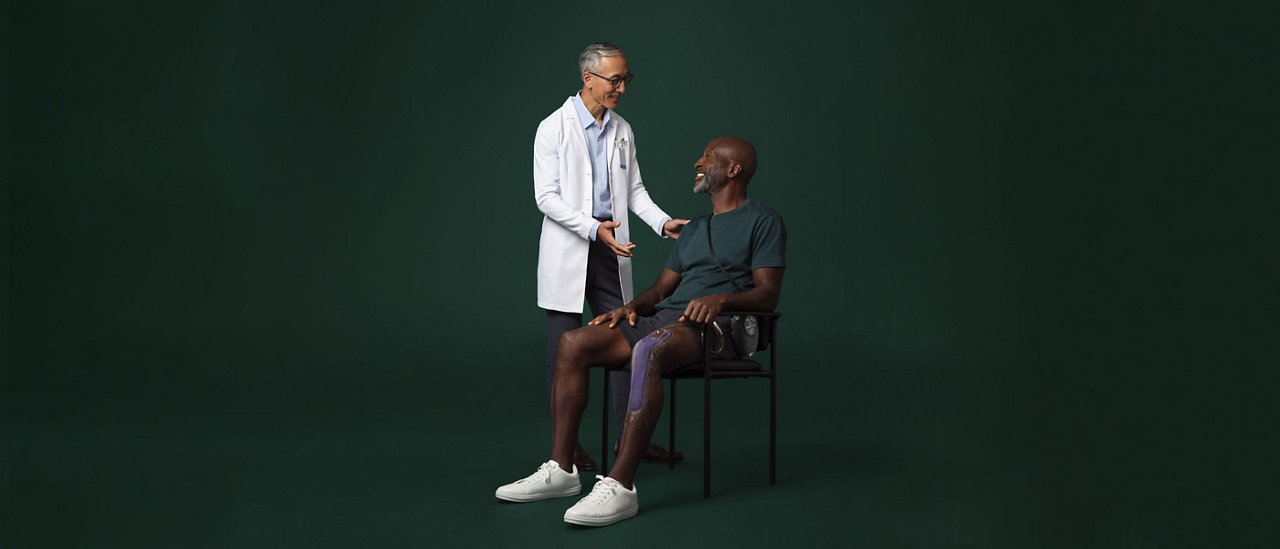The art and science of wound care: Help for healing
April 01, 2024 | Read time: 4 min

The body can do amazing things to heal itself. But with wounds or surgical incisions, patients sometimes need additional, specialized care. Solventum helps to solve these tough challenges by supporting clinicians and patients with advanced solutions and support through the wound healing process to help improve outcomes.
Self-healing wounds were only a small percentage of what Kimberly Smith, an RN and Solventum clinical specialist, saw while practicing as a home healthcare nurse.
“Chronic wounds — or wounds that fail to progress — are a major challenge,” says Kimberly. In fact, chronic, nonhealing wounds impact about 8.2 million Medicare beneficiaries, according to a 2021 article published in Advances in Wound Care. Current estimates show that about 2.5% of people in the U.S. suffer with chronic wounds which impact their quality of life.*
Hope for patients with chronic wounds
Chronic wounds can cause anxiety and keep patients homebound — and not just from physical pain, but emotional pain as well. Kimberly hopes that by working directly with clinicians and educating them about wound management and the solutions available, she can help patients get to a better place — physically and emotionally.
Kimberly says some treatments can be used in combination to make a meaningful difference. She recalls a patient who was homebound because of a venous leg ulcer, a chronic wound that was not healing. The patient was afraid to go to church and wouldn’t visit family.
Kimberly recalls that with a combination of dressing and wound care treatments, she saw a big change. “After five weeks of treatment, she started going out and seeing her family again.”
Technological advances to help people return home
Surgeons also rely on the patient’s body to do the work of healing after surgery, but sometimes, that’s not enough. More than 25 years ago a new treatment for complex wounds was invented: negative pressure wound therapy. It has dramatically changed how clinicians can provide care for patients with significant wounds and higher-risk surgical incisions.
During the COVID-19 pandemic, there was an even greater need to move patients out of the hospital as quickly as possible — both to keep beds available and because patients preferred to be at home. One solution uses dressings that protect incisions for longer, which may enable patients to heal comfortably at home. 3M™ Prevena™ Therapy offloads tension on the incision and allows a wound to heal without interference. It’s covered, so the patient can’t see or touch it, plus they can even confidently shower with it on.
Education and insights from clinicians to clinicians
In addition to wound care technology itself, education can play an important role in improving outcomes. “We are subject matter experts in the area of wound care and if we reach healthcare providers it can have a large impact,” Kimberly says. “The more education we can provide, the better the outcome we can achieve.”
Insights and learnings work in both directions between our Solventum team and clinicians — and it starts with listening and observing. Kimberly says she always looks for chances to learn from others while she is on the job. Her advice? Take opportunities to learn from the team treating your patients. “It’s important to treat the whole patient,” she says. “When you work with a team, you can learn from them, and it helps you see the patient holistically.”
NOTE: Specific indications, contraindications, warnings, precautions and safety information exist for these products and therapies, some of which may be Rx only. Please consult a clinician and product instructions for use prior to application.
Footnote:
*Chandan K. Sen.Advances in Wound Care.May 2021.281 292.
As with any case study, the results and outcomes should not be interpreted as a guarantee or warranty of similar results. Individual results may vary depending on the patient’s circumstances and condition.


